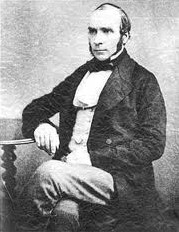|
John Snow
1813 – 1858
“All who knew him said he was a quiet man, very reserved and
peculiar - a clever man, but not easy to be understood, and
very peculiar." - B.W. Richardson, a close friend and
writer of a biographical memoir which first appeared in The
Asclepiad, London, 1887, and now can be found in Snow on
Cholera.
Throughout his life, John Snow devoted himself to the welfare of
others; he never married and lived a life of "student loneliness,"
according to Richardson. However, "with his increased popularity,
he became less reserved to strangers, and in the last years of his
life he so far threw off restraint as to visit the opera
occasionally!" |

|
|
Ether and Chloroform
Snow's career was dominated by experiments with various procedures
regarding inhalation. Two years before Mr. became Dr. in 1848, his
first attempt at authorship involved a double air pump for
supporting artificial respiration. Only months later, he invented
an instrument "for performing the operation of paracentesis of the
thorax".
In 1846, news came from America that operations were being
performed painlessly under the influence of ether. Surgeons in
England, however, remain skeptical of the practice, due to the
unsafe method by which the agent was administered. Dr. Snow, upon
detecting the cause of the problem, quickly remedied this by
developing an improved inhaler.
Soon he was administering ether all over London. In his first book
in September 1847, he wrote of all his experiences with
etherisation. However, just as the book began to be appreciated,
"the discovery of the application of chloroform threw ether into
the shade, and the book with it".
Once Dr. Snow was convinced of the effects and the
greater practicality of this new agent, he began using it in
earnest. He soon developed a professional reputation, and people
from all over sought him out as their guide in "Lethe’s Walk." His
diary tells us he administered chloroform to the Queen at the
birth of Prince Leopold and Princess Beatrice.
The Great Cholera Epidemic
By the time of the London cholera epidemic in 1854, Dr. Snow was
ready to test his ideas regarding the transmission of the disease.
He had begun his research on cholera in 1848, and contrary to the
belief at the time, he was convinced that it was a poison acting
not on the respiratory system, but on the alimentary canal.
Several circumstances led him to believe that water was the chief
medium. So, toward the end of August 1854, when there were more
than 500 fatal attacks on cholera in 10 days in the neighborhood
of Broad Street, Golden Square, and there was such panic that
"people fled from their homes as from instant death, leaving
behind them in all their haste, all which they valued most," Dr.
Snow offered a new suggestion: Since, he said, the Broad Street
pump was the "head and front of the offending," he advised the
removal of the pump handle as the "grand prescription." Those who
heard him were skeptical of this newfangled approach, but they
took his advice, and the plague was stayed.
He published the "Mode of Communication at Cholera" in 1855 - for
which "he spent more than £200 in hard cash, and realized in
return scarcely so many shillings".
Epidemiology
Richardson encapsulates Snow’s epidemiologic ideas thus: "The
position he took as an epidemiologist was original, and in
opposition to the views of many eminent men who had, in matters
relating to public health, considerable scientific and political
influence."
It was accepted at the time that an "emanation arising from
evolution of foul smelling gases" could produce a specific
disease. But according to Snow: "The small-pox may occur over a
cesspool as an oak may spring up through manure heap; but the
small-pox would never appear over the cesspool in the absence of
its specific poison: nor the oak rise from the manure heap in the
absence of the acorn which seeded it".
"exit"
Snow's life was filled with experimentation, often with volatile
agents. He first tested them him on animals, and if it proved
favorable, he tried it on a human - - himself. He ran great risks,
and many suppose they had an effect in bringing about his early
death. On June 9, 1858, while at work on a manuscript, he was
seized with sudden paralysis just as he had written the word
"exit". He died eight days later, at the height of his success.
Source: Excerpted from the introduction to Snow on Cholera,
by B.W. Richardson. Cambridge, Harvard University Press, 1949. |